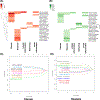Nonalcoholic fatty liver disease risk and histologic severity are associated with genetic polymorphisms in children
- PMID: 35560106
- PMCID: PMC9653518
- DOI: 10.1002/hep.32570
Nonalcoholic fatty liver disease risk and histologic severity are associated with genetic polymorphisms in children
Abstract
Background and aims: NAFLD is the most common chronic liver disease in children. Large pediatric studies identifying single nucleotide polymorphisms (SNPs) associated with risk and histologic severity of NAFLD are limited. Study aims included investigating SNPs associated with risk for NAFLD using family trios and association of candidate alleles with histologic severity.
Approach and results: Children with biopsy-confirmed NAFLD were enrolled from the NASH Clinical Research Network. The Expert Pathology Committee reviewed liver histology. Genotyping was conducted with allele-specific primers for 60 candidate SNPs. Parents were enrolled for trio analysis. To assess risk for NAFLD, the transmission disequilibrium test was conducted in trios. Among cases, regression analysis assessed associations with histologic severity. A total of 822 children with NAFLD had mean age 13.2 years (SD 2.7) and mean ALT 101 U/L (SD 90). PNPLA3 (rs738409) demonstrated the strongest risk ( p = 2.24 × 10 -14 ) for NAFLD. Among children with NAFLD, stratifying by PNPLA3 s738409 genotype, the variant genotype associated with steatosis ( p = 0.005), lobular ( p = 0.03) and portal inflammation ( p = 0.002). Steatosis grade associated with TM6SF2 ( p = 0.0009), GCKR ( p = 0.0032), PNPLA3 rs738409 ( p = 0.0053), and MTTP ( p = 0.0051). Fibrosis stage associated with PARVB rs6006473 ( p = 0.0001), NR1I2 ( p = 0.0021), ADIPOR2 ( p = 0.0038), and OXTR ( p = 0.0065). PNPLA3 rs738409 ( p = 0.0002) associated with borderline zone 1 NASH.
Conclusions: This study demonstrated disease-associated SNPs in children with NAFLD. In particular, rs6006473 was highly associated with severity of fibrosis. These hypothesis-generating results support future mechanistic studies of development of adverse outcomes such as fibrosis and generation of therapeutic targets for NAFLD in children.
Copyright © 2022 American Association for the Study of Liver Diseases.
Conflict of interest statement
CONFLICTS OF INTEREST
Ajay K. Jain advises Mirum Pharma. He consults for and received grants from Camp 4. Jeffrey B. Schwimmer received grants from Intercept, Genfit, and Seraphina. Jean P. Molleston received grants from Gilead, AbbVie, Albireo, and Shire. Stavra A. Xanthankos received grants from Target RWE.
Figures



References
-
- Schwimmer JB, Deutsch R, Kahen T, Lavine JE, Stanley C, Behling C. Prevalence of fatty liver in children and adolescents. Pediatrics 2006;118(4):1388–93. - PubMed
-
- Molleston JP, White F, Teckman J, Fitzgerald JF. Obese children with steatohepatitis can develop cirrhosis in childhood. Am J Gastroenterology 2002;97(9):2460–2. - PubMed
Publication types
MeSH terms
Grants and funding
- U01 DK061731/DK/NIDDK NIH HHS/United States
- UL1 TR000006/TR/NCATS NIH HHS/United States
- P30 DK120515/DK/NIDDK NIH HHS/United States
- U01 DK061728/DK/NIDDK NIH HHS/United States
- UL1 TR000454/TR/NCATS NIH HHS/United States
- UL1 TR000448/TR/NCATS NIH HHS/United States
- U01 DK061734/DK/NIDDK NIH HHS/United States
- UL1 TR000004/TR/NCATS NIH HHS/United States
- UL1 TR002345/TR/NCATS NIH HHS/United States
- U01 DK061737/DK/NIDDK NIH HHS/United States
- U01 DK061713/DK/NIDDK NIH HHS/United States
- U01 DK061732/DK/NIDDK NIH HHS/United States
- UL1 TR000150/TR/NCATS NIH HHS/United States
- U01 DK061718/DK/NIDDK NIH HHS/United States
- UL1 TR001442/TR/NCATS NIH HHS/United States
- U01 DK061730/DK/NIDDK NIH HHS/United States
- U24 DK061730/DK/NIDDK NIH HHS/United States
- U01 DK061738/DK/NIDDK NIH HHS/United States
- UL1 TR000424/TR/NCATS NIH HHS/United States
- UL1 TR000040/TR/NCATS NIH HHS/United States
- UL1 TR000077/TR/NCATS NIH HHS/United States
- UL1 TR000423/TR/NCATS NIH HHS/United States
- UL1 TR000100/TR/NCATS NIH HHS/United States

